Breaking down human trafficking statistics in Montreal: Data, trends, and efforts
- Key Insights
- Current Human Trafficking Statistics in Montreal
- Demographics of human trafficking victims in Montreal
- Demographics of the accused in Montreal
- Trafficking networks and methods in Montreal
- Law enforcement and legal efforts against human trafficking in Montreal
- Challenges in addressing human trafficking in Montreal
- Public awareness and initiatives in Montreal
- Impact of human trafficking on Montreal’s society
- References
Key Insights
| According to Statistics Canada, Montreal ranks among the top 5 CMAs for human trafficking. There were 264 police-reported incidents from 2013 to 2023, accounting for 6% of all cases. Women and girls make up the vast majority of human trafficking victims in Canada. They account for 93% of the 3,558 police-reported cases between 2013 and 2023, according to Statistics Canada. Statistics Canada reports that 91% of the victims know their trafficker, 34% are with intimate partners, and 22% are casual acquaintances. Canada’s National Strategy to Combat Human Trafficking, led by Public Safety Canada, commits $75 million to anti-trafficking initiatives. According to the Government of Canada, human trafficking inflicts lasting physical, psychological, and economic harm on victims and society. Victims suffer from issues like PTSD, substance abuse, and long-term healthcare needs. |
Human trafficking affects vulnerable individuals in Montreal, placing significant strain on law enforcement and social services.
According to Statistics Canada, 570 trafficking incidents were reported across Canada in 2023, a slight decrease from 597 in 2022.
It’s important to note that official statistics in Canada are difficult to pin down accurately, as the crime is often hidden and unreported. Detecting trafficking heavily relies on victims reporting the event.
Current Human Trafficking Statistics in Montreal
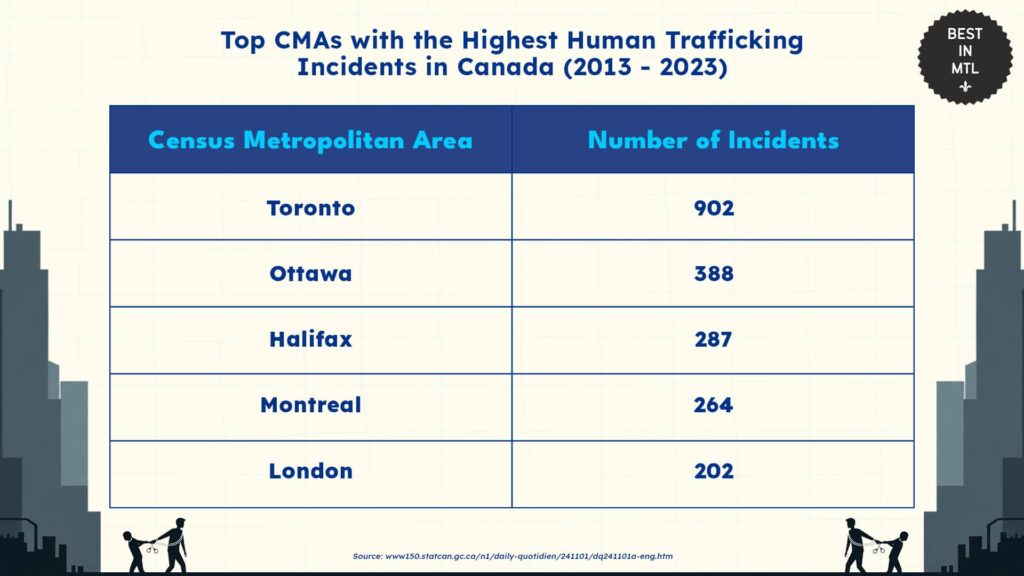
Human trafficking is a major concern in Montreal, with the city ranking among the top 5 census metropolitan areas (CMAs) in Canada for reported incidents.
According to Statistics Canada, Montreal accounted for 264 police-reported incidents between 2013 and 2023, making up 6% of all cases nationwide.
Toronto had the highest number of incidents, 902. Ottawa followed with 388, while Halifax recorded 287. Lastly, London similarly reported high numbers, with 202 incidents in 2023.
To shed more light on the issue, 85% of human trafficking incidents were reported in CMAS in 2023 alone. This indicates that urban areas like Montreal continue to be hotspots for trafficking activity.
While statistics provide insight into the scale of the issue, it’s equally important to see its limits. That is, police-reported data don’t account for victim mobility. This means that many individuals may have been trafficked through Montreal rather than originating from or remaining in the city.
Demographics of human trafficking victims in Montreal
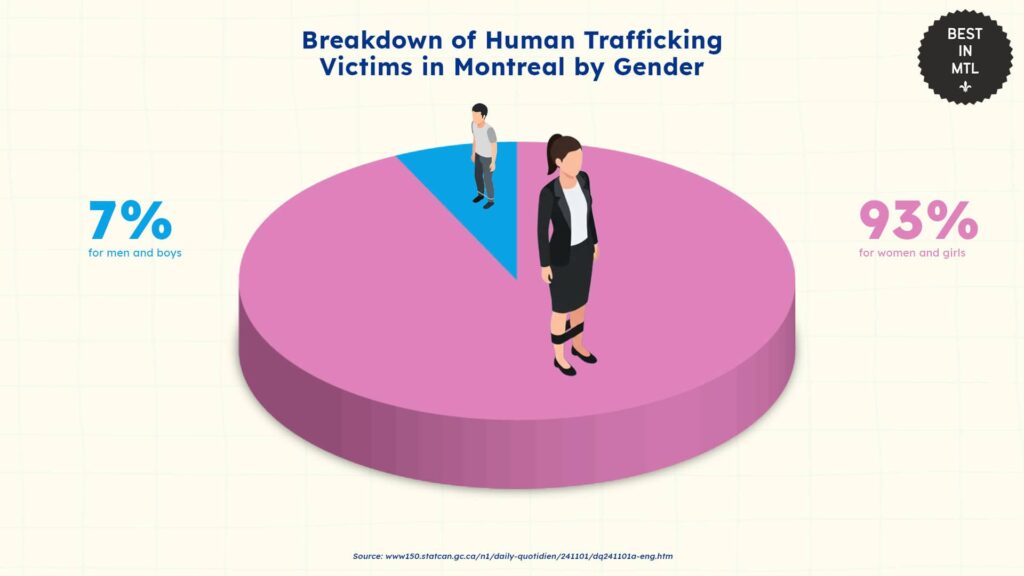
As per the report of Statistics Canada, women and girls make up the overwhelming majority of human trafficking cases, not just in Montreal but for the entire country.
Women, girls, and minors
Between 2013 and 2023, 93% of the 3,558 police-reported victims in Canada were women.
Among women and girls specifically, two-thirds (68%) were under 24 years old.
Additionally, nearly one-quarter (23) of victims were minors, emphasising the vulnerability of children and youth to trafficking.
Young adults
Young adults are also disproportionately affected, with 42% of victims falling within the 18 to 24 age group. A further 23% were aged 25 to 34 years old, meaning that nearly two-thirds of all victims were under 35.
Men and boys
While men and boys represent a much smaller percentage of victims (7%), their experiences should not be overlooked. Notably, 88% of male victims were adults.
This indicates that trafficking can affect individuals of all genders, though it’s evident that women remain the primary targets.
Demographics of the accused in Montreal
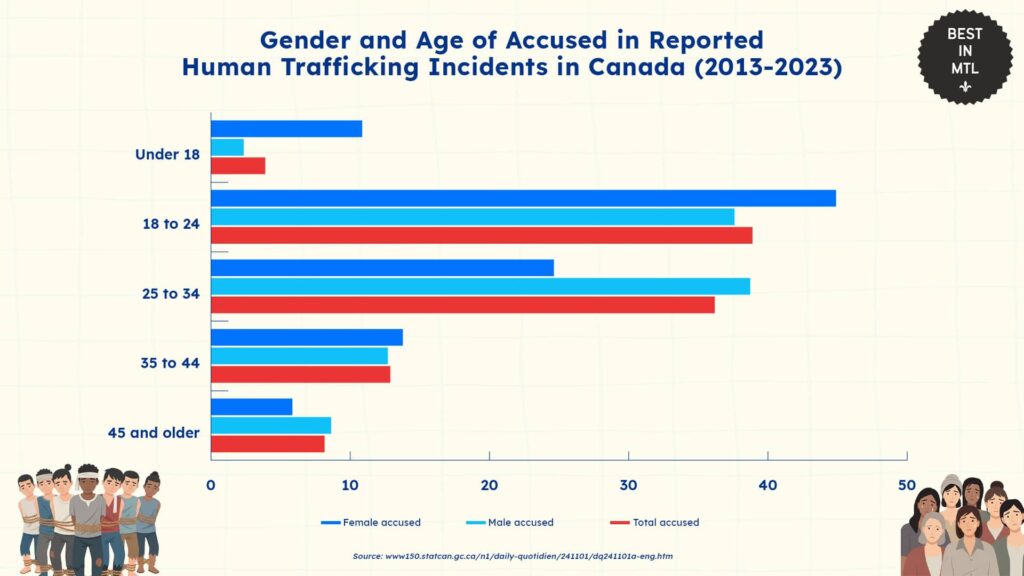
According to Statistics Canada, police-reported human trafficking incidents between 2013 and 2023 show that 82% of those accused were men and boys.
39% of this proportion is made up of men and boys aged 18 to 24, and 36% are aged 25 to 34.
Interestingly, when it comes to youth, the gender gap narrows. Among 105 of the youth accused (aged 12 to 17), boys and girls were represented equally, with each gender accounting for 50% of the cases.
This data suggests that while men dominate the adult accused category, both genders are implicated at similar rates within younger age groups.
Trafficking networks and methods in Montreal
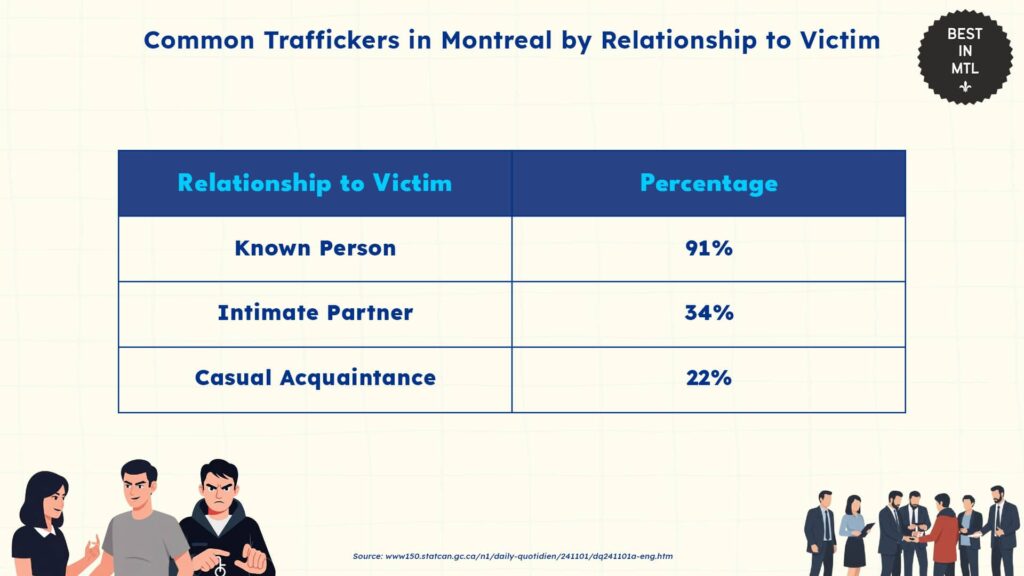
While there is no exact data or record on the specific trafficking networks and methods used to lure in victims, there’s a lot that can be inferred from police records.
As per Statistics Canada, human trafficking in Montreal operates primarily through relationships of trust and manipulation rather than random abductions.
Data from 2013 to 2023 indicates that 91% of victims know their trafficker. The most common perpetrators are intimate partners, making up 34%. They’re followed by casual acquaintances at 22%.
Traffickers often exploit emotional vulnerabilities, a method of coercion often referred to as “lover-boy” and “Romeo pimp” tactics. This makes it difficult for victims to recognise the danger until they are fully trapped in the cycle of trafficking.
The majority of those accused of human trafficking in Canada were young men.
From 2013 to 2023, 82% of 2,697 individuals accused were men and boys, with the largest population of 39% being between 18 to 24 years old.
This data suggests that trafficking operations are often run by young individuals, possibly due to connections within peer networks or the ability to relate to victims of similar ages.
Law enforcement and legal efforts against human trafficking in Montreal
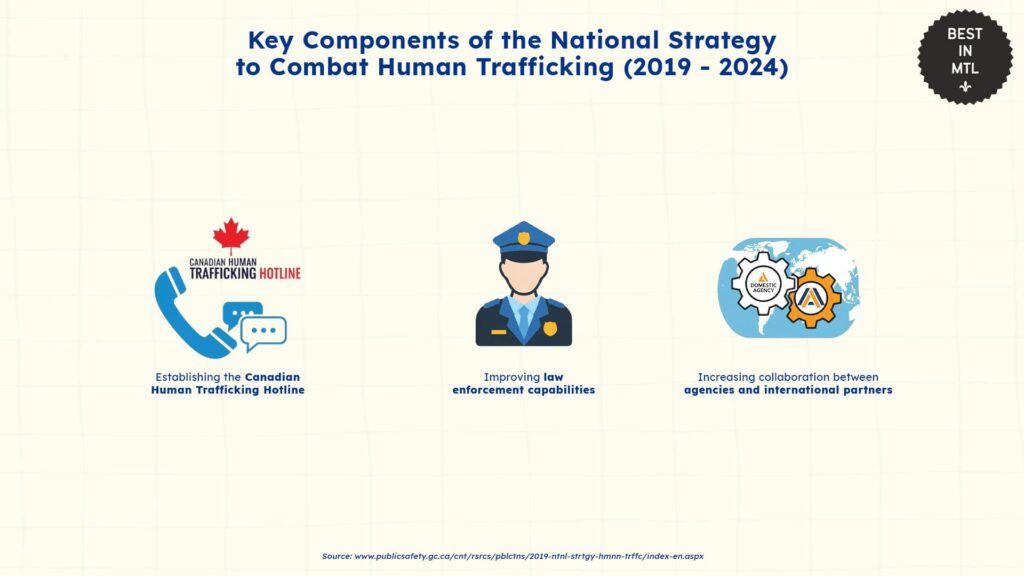
There are no city-specific initiatives to combat human trafficking in Montreal. However, there is a nationwide fight against the issue.
Canada has adapted a comprehensive, whole-of-government approach to combat human trafficking. Public Safety Canada oversees the National Strategy to Combat Human Trafficking and coordinates efforts with other federal partners.
To strengthen its response, Canada has committed $75 million over 6 years to anti-trafficking initiatives. This includes funding for the Canadian Human Trafficking Hotline, which provides immediate support for victims.
A key component of the National Strategy is improving law enforcement capabilities. This includes enhancing intelligence-sharing and increasing collaboration between government agencies, police forces, and international partners.
Challenges in addressing human trafficking in Montreal
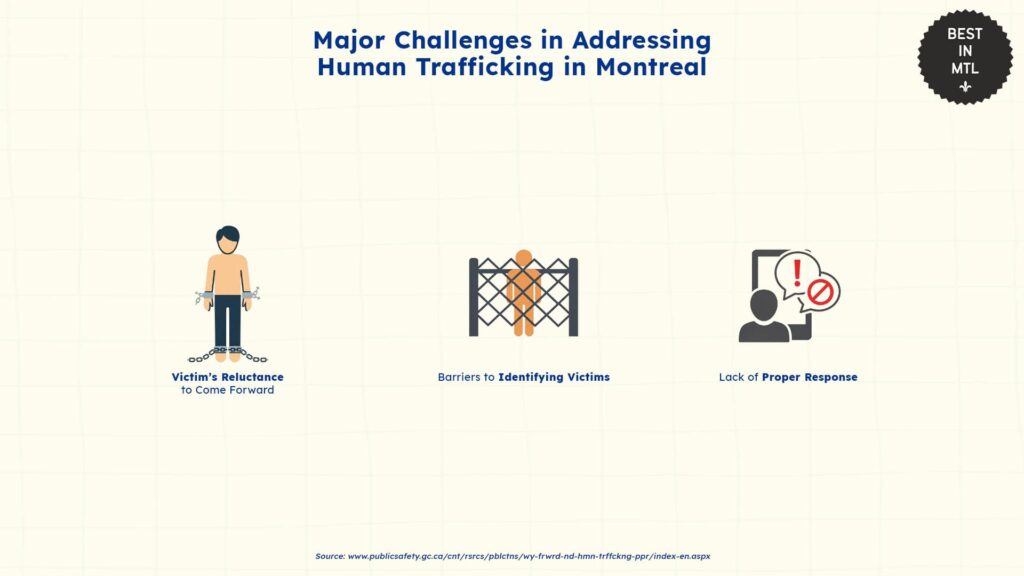
As discussed by Public Safety Canada in The Way Forward to End Human Trafficking, one of the biggest challenges in addressing human trafficking in Canada is the difficulty of assessing its full extent.
Due to the hidden nature of the crime, many cases go undetected, making it hard for law enforcement and policymakers to gather accurate statistics.
The same can be said for Montreal’s numbers. In general, challenges can be attributed to the following:
- Victims’ Reluctance to Come Forward: Many victims of human trafficking don’t report their experiences due to fear, shame, and intimidation, as traffickers frequently use threats of violence to control their victims.
- Barriers to Identifying Victims: Language barriers, mistrust of law enforcement, and lack of awareness about victims’ rights all contribute to the challenges. Some victims don’t even recognise they’re being trafficked.
- Lack of Proper Response: Even when cases are identified, law enforcement and social service agencies face numerous challenges in responding effectively. These cases require specialised training, resources, and cooperation between multiple agencies, which can be challenging.
Public awareness and initiatives in Montreal
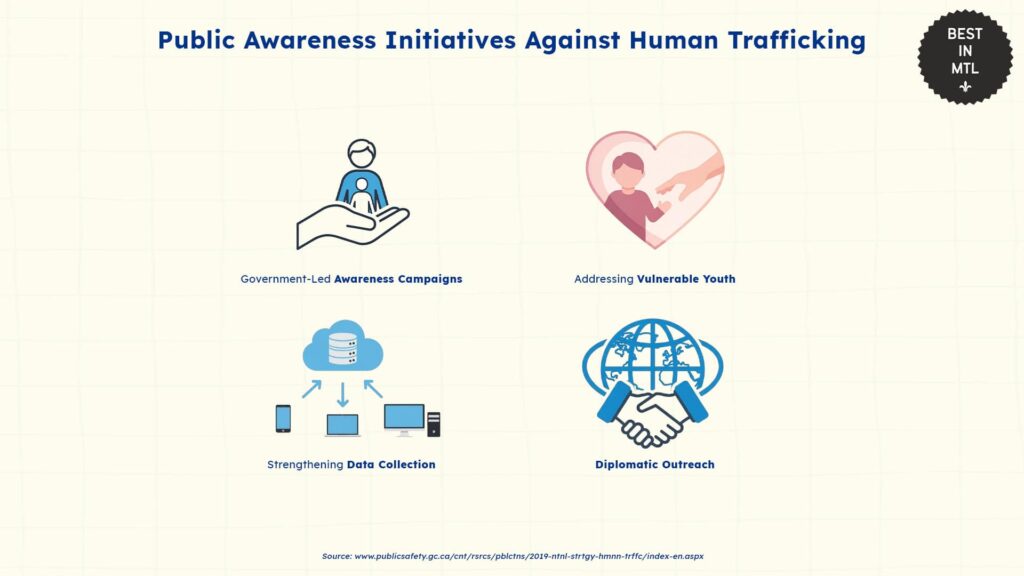
As part of the National Strategy, Public Safety Canada enforces public awareness to help combat human trafficking in Montreal and across the country.
- Government-Led Awareness Campaigns: As discussed previously, the National Strategy will help educate Canadians on the different forms of trafficking and their consequences. Such campaigns aim to mobilise communities and report suspicious activities.
- Addressing Vulnerable Youth: Pilot projects under the National Strategy are focused on at-risk youth and aim to tackle the core drivers of trafficking, such as poverty, lack of stable housing, and social isolation.
- Strengthening Data Collection: By closing data gaps and enhancing the knowledge base, policymakers can develop more targeted and effective anti-trafficking initiatives.
- Diplomatic Outreach: The government is working to tackle the root causes of trafficking through international assistance and partnerships. Canadian embassies and consular officials are also raising awareness among diplomats and travelers.
Impact of human trafficking on Montreal’s society
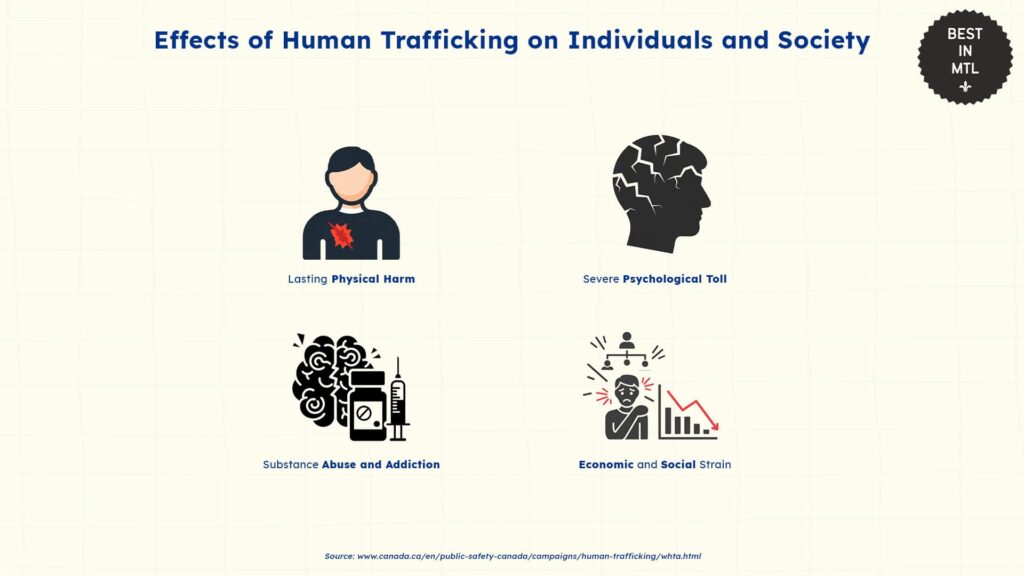
For victims of human trafficking in Montreal and across Canada, the psychological and physical tolls are evident. The Government of Canada highlights some of the effects of trafficking on individuals and society:
- Lasting Physical Harm: Physical injuries from violence, malnutrition, and overwork are common. Long-term complications can also persist even after a victim escapes their trafficker.
- Severe Psychological Toll: The experience of being controlled, abused, and dehumanised can lead to depression, anxiety, and post-traumatic stress disorder (PTSD). Many victims also struggle to trust others, making it difficult to reintegrate into society.
- Substance Abuse and Addiction: Traffickers often use drugs and alcohol as a method of control, forcing victims into substance dependency to keep them compliant. Others may turn to substances as a way to cope with their trauma.
- Economic and Social Strain: Healthcare costs rise and victims require long-term medical and psychological care. Law enforcement and social services must dedicate extensive resources to identifying, rescuing, and rehabilitating survivors.
References
- Government of Canada. Who does human trafficking affect? (n.d.). https://www.canada.ca/en/public-safety-canada/campaigns/human-trafficking/whta.html
- Public Safety Canada. National Strategy To Combat Human Trafficking 2019-2024 (n.d.). https://www.publicsafety.gc.ca/cnt/rsrcs/pblctns/2019-ntnl-strtgy-hmnn-trffc/index-en.aspx
- Public Safety Canada. The Way Forward to End Human Trafficking (n.d.). https://www.publicsafety.gc.ca/cnt/rsrcs/pblctns/wy-frwrd-nd-hmn-trffckng-ppr/index-en.aspx
- Statistics Canada. Trafficking in persons in Canada, 2023 (2024). https://www150.statcan.gc.ca/n1/daily-quotidien/241101/dq241101a-eng.htm













